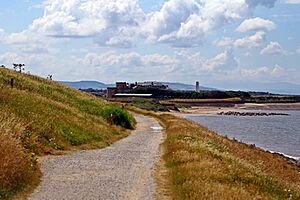Leasowe Lighthouse facts for kids
| Tower shape | Cylindrical tower with balcony and removed lantern |
|---|
Leasowe Lighthouse is a very old and important lighthouse located in Moreton, England. It sits on the Wirral Peninsula in Merseyside. Built in 1763, this lighthouse helped guide ships safely to the Port of Liverpool. It's special because it's the oldest brick-built lighthouse in the United Kingdom! The lighthouse stopped working in 1908 because the sandbanks shifted. The last person to look after it was Mrs. Williams, who was the only known female lighthouse keeper at that time.
Contents
The Story of Leasowe Lighthouse
In 1761, a special law called an Act of Parliament was passed. This law allowed the people in charge of the Liverpool Docks to build four lighthouses. Two of these lighthouses were built in Moreton. They were called the Upper Mockbeggar Light and the Lower Mockbeggar Light.
Guiding Ships to Liverpool
When these two lights lined up, they showed ships a safe path. This path was called "Rock Channel." It led ships safely into the Port of Liverpool. The Upper Mockbeggar Light is what we now call Leasowe Lighthouse. The Lower Mockbeggar Light was built closer to the sea. Sadly, a big storm destroyed it in 1769. A new lighthouse, Bidston Lighthouse, was built in 1771 to replace it.
The other two lighthouses allowed by the law were built in Hoylake. The name Hoylake comes from "Hoyle Lake." This was a channel of water between Hilbre Island and Dove Point. Hoyle Lake was a safe place for ships to anchor. It was protected by a large sandbank called Hoyle Bank.
When the Lighthouse Closed
Leasowe Lighthouse was used until July 14, 1908. By this time, the sandbanks in the sea had moved a lot. This made the Rock Channel very hard for ships to use. Because of this, the lighthouse was no longer needed.
The lighthouse was both a workplace and a home. Mrs. Williams was the last lighthouse keeper. She was the only female lighthouse keeper known during that time. After the lighthouse closed, Mrs. Williams moved into a nearby cottage. She kept the lighthouse open as a tearoom during the summer.
In 1930, the Wallasey Corporation bought the lighthouse. Mrs. Williams passed away in 1935, and the building was then closed. In 1952, Leasowe Lighthouse was listed as a historic Grade II building. This means it is an important building that needs to be protected.
Bringing the Lighthouse Back to Life
After closing, the lighthouse fell into disrepair and became run down. But then, a community group stepped in! They were called "The Friends of Leasowe Lighthouse." This group worked hard to restore the lighthouse. Thanks to them, it is now in good condition again.
How Leasowe Lighthouse Was Built
Leasowe Lighthouse is a tall, round tower that gets narrower as it goes up. It is 101 feet (about 31 meters) tall. It has thick walls with a space inside them. The lighthouse also has a plain balcony near the top.
Building Materials and Design
Builders used 660,000 handmade bricks to construct the lighthouse. It has seven floors inside. The original staircase was made of wood. But in 1898, it was replaced with a new one made of cast iron. This new staircase has 130 steps!
The light itself first burned coal. In 1772, it was changed to burn oil instead. An engineer named Robert Stevenson visited in 1801. He noted that the tower had a special reflector made of silvered glass. Later, in 1861, the lighthouse reportedly used eight Argand lamps with special reflectors. The lighthouse was looked after by a keeper and an assistant, who lived inside the tower.
Where to Find Leasowe Lighthouse
The lighthouse is located on Moreton Common. This area is close to Mockbeggar Wharf. The wharf gets its name from "Mockbeggar Hall." This is another name for the nearby Leasowe Castle.
The area around the lighthouse is part of the North Wirral Coastal Park. People use this park for fun activities like walking and watching birds. It's a great place to enjoy nature!
What You Can Do at the Lighthouse Today
Leasowe Lighthouse is now a community hub. It hosts many different activities. The ranger service for the North Wirral Coastal Park also uses it.
Activities and Visits
The lighthouse is used for charity events like abseiling. People also visit for paranormal tours. Running groups meet there, too. Film and television companies have even used the lighthouse as a filming location!
The lighthouse has a small visitor center. It is a main attraction in the North Wirral Coastal Park. You can visit Leasowe Lighthouse on the first and third Sunday of every month.


